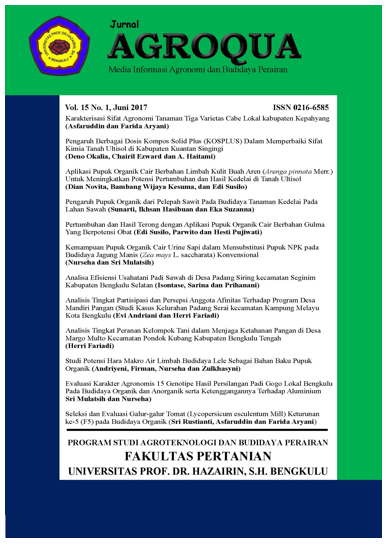RESPON TANAMAN CABAI MERAH (Capsicum annum L.) PADA PEMBERIAN MACAM DAN DOSIS BOKASHI LIMBAH PERTANIAN
DOI:
https://doi.org/10.32663/ja.v19i1.1698Keywords:
coffee leather waste bokhasi, chicken manure bokashi, from cow dung bokashiAbstract
The aim of this study was to determine the response of red chili (Capsicum annum L.) to the kinds and dosages of agricultural waste bokashi. This research was conducted in podzolic land in the Sawah Lebar, Ratu Agung sub-district, Bengkulu City with an altitude of 18 m above sea level, from December 2019 to March 2020. This research was arranged in a completely randomized design (RAL) with two treatments, kinds, and dosage of bokashi. The treatment was repeated 3 times in order to obtain 27 experimental units. The treatment of agricultural waste bokashi had a significant effect on plant height variables aged 3 weeks after planting and 4 weeks after planting, very significant effect on plant height at 6 weeks after planting, flowering age, and harvesting age of red chili plants. At the 3 weeks after planting, 4 weeks after planting, 6 weeks after planting plant height variables, flowering age showed that the leather waste coffee bokashi treatment showed the best results which were not significantly different from cow dung bokashi treatment and significantly different from chicken manure bokashi treatment. The dosage treatment of agricultural waste bokashi had a very significant effect on the variable of harvest age. no significant effect on the variables of plant height, flowering age, fruit weight per plant, wet stover weight, and plant dry stover weight. the harvest age variable showed that the treatment of dosage of 15 ton/ha of bokashi had the best result which was significantly different from that of 20 ton/ha and 25 ton/ha of bokashi treatment. The interaction of kinds and dosages of agricultural waste bokashi did not significantly affect the observed variables.
References
Downloads
Published
Issue
Section
License
Authors who publish with this journal agree to the following terms:
- Authors grant the journal right of first publication with the work simultaneously licensed under a Creative Commons Attribution 4.0 Internasional (CC BY 4.0) Licence that allows others to use and share the work with an acknowledgment of the work's authorship and initial publication in this journal.
- The author(s) still hold the copyright of his/her/their work and retain publishing rights without restrictions such as (but not limited to) patent right, lecture, book and reproduce the article for own purposes.
















